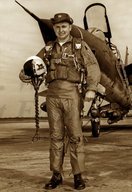
|

|
|
|
|
Born at home in Moss Hill, Texas, Larry was one of four sons of Luther Elgin Wiggins and Ethel Leona Atkinson Wiggins. His father farmed, raised cattle, and worked in the oil fields. Larry helped work cattle on horseback. He picked cotton, milked cows, gathered eggs, and fed hogs on the family farm. In leisure time he rode his bicycle, played ball, and listened to the radio, operated by a dry-cell battery. In 1948 the family moved to Smithville, Arkansas, where they farmed "a year or two" until his father found work in the oil fields in Hobbs, New Mexico. The family moved back to Arkansas for a brief stay, then came home to Moss Hill where Larry graduated from Hardin High School in 1951. Over the next year he held several jobs, including those of a roustabout and a roughneck in oil fields. He also worked as a longshoreman in Houston. Larry enrolled at Sam Houston State College in Huntsville, Texas, in the fall of 1952, remaining in school for a year and a half until his money ran out. He joined the U.S. Air Force hoping to be a pilot. He took pre-flight training at Lackland Air Force Base in San Antonio, primary training at Stallings Air Base in Kinston, North Carolina, then basic training at Bryan Air Force Base in Bryan, Texas, where he first flew a jet aircraft. He was commissioned there upon graduation in 1955, and sent to Moody Air Force Base in Valdosta, Georgia, where he was assigned to an F-94, a jet fighter designed to intercept Russian TU-2 bombers. On December 27, 1956 he married Dorothy Ford. (They would have one son, Forrest.) Larry, who also flew the F-86L "Sabre," was sent to the Air Force Institute of Technology at Wright-Patterson Air Force Base, Ohio, then spent a year at Kirtland Air Force Base in Albuquerque, New Mexico, as a project engineer with special weapons. At Nellis Air Force Base in Las Vegas, Nevada, he checked out in the F-105 "Thunderchief", an aircraft capable of carrying a nuclear bomb, and practiced low-level nuclear missions at McConnell Air Force Base at Wichita, Kansas. Larry was sent overseas to Spangdahlem Air Force Base in Pickliessem, Germany. Dorothy joined him, and the couple enjoyed living in a home with a German family. In mid-1966, during the Vietnam War, he was sent to Clark Air Base in the Philippines for jungle survival training, then on to Korat Air Base in Thailand, where he was assigned to the 469th Tactical Fighter Squadron of the 388th Tactical Fighter Wing. Pilots flew the F-105s to targets only in North Vietnam, specifically around Hanoi and the southern area of the Communist nation. Once, he says, he flew within a half-mile of the Chinese border. On another mission he helped destroy the only steel mill in North Vietnam. Many other sorties, he recalls disappointedly, were against very low-value targets, while other potential targets were off-limits. "I've flown right over Kep Airfield and we weren't allowed to hit their aircraft on the ground. The MiGs had to be airborne for us to destroy them," he recalls. "It was civilian people picking out our targets instead of the military." On his fifty-first mission, he says, aircraft of two pilots went down, struck by SAM missiles or due to engine failure. The pilots spent the war in North Vietnamese prisons and returned home in February of 1973 on the second planeload of prisoners of war released from Hanoi. Larry knew others who also spent time as prisoners of war. "I had sixteen friends on that aircraft," he recounts. Meanwhile, he wrote Dorothy letters and sent audiotapes, including some documenting a few of his missions. Although officially, he says, "we didn't have missions in Laos," he flew ten sorties over that country, including a strafing mission. No aircraft in the 469th were shot down by MiG-17s, or MiG-21s, he reports. On June 3, 1967, during a mission to bomb Bac Giang Bridge, about thirty-five miles northeast of Hanoi, he and fellow pilot Ralph Kuster both shot downed MiG aircraft. Larry shot his down with one of his Sidewinder AIM-9 missiles. A bomb assessment camera under his aircraft nose recorded the hit--the only Sidewinder kill recorded as it happened during the war. In arriving above his air base, he performed the customary "victory roll" allowed after a pilot downs an enemy aircraft. "There was a lot of happiness, but I don't think we did anything in particular to celebrate," he recalls. It was his 75th mission, he believes. "I felt I had a guardian angel," he says of his service in the skies above North Vietnam. "When we engaged these MiGs I spoke to my angel. I said, `Angel, watch behind me. I don't have time.'" After flying his 100th mission a few weeks later, he was discharged at Travis Air Force Base in San Jose, California, on July 19, 1967. Back home in Houston, he wanted to fly for American Airlines, but the company was not hiring pilots at that time. Instead, he sold insurance and cars until he was employed as an air traffic controller at Air Traffic Control Center in Houston, where he worked for 21 years. He retired in 1991. |


